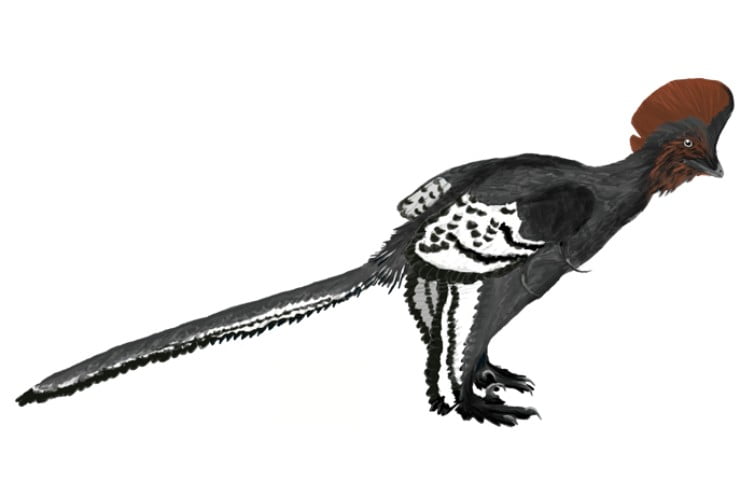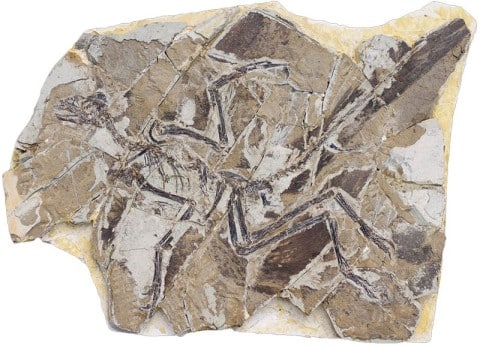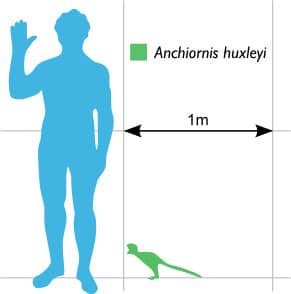In the field of paleontology, few creatures capture the imagination quite like the Anchiornis. This dinosaur, whose name translates to ‘near bird’, offers a fascinating glimpse into the evolutionary journey from reptiles to birds. A member of the theropod group, it hails from the Late Jurassic era, a time when the world was teeming with a diverse array of prehistoric life.
The Anchiornis is a testament to the wonders of natural history, a creature that once roamed the earth millions of years ago. Its discovery in the Tiaojishan Formation in China has provided invaluable insights into the rich tapestry of life during the Late Jurassic period. With its carnivorous diet and unique features, this is a remarkable specimen that continues to intrigue and inspire scientists and enthusiasts alike.
Key Facts
| Keyword | Fact |
|---|---|
| Anchiornis pronunciation | ank-ee-or-niss |
| Meaning of name | Near bird |
| Group | Theropod |
| Type Species | Anchiornis huxleyi |
| Diet | Carnivore |
| When it Lived | 163.5 to 157.3 MYA |
| Period | Late Jurassic |
| Epoch | Oxfordian |
| Length | 1.12 to 2.03 ft |
| Height | 1.1 ft |
| Weight | 0.001 tons |
| Mobility | Moved on two legs |
| First Discovery | 2009 by Xing Xu, Qi Zhao, Mark Norell, Corwin Sullivan, David Hone, Gregory Erickson, XiaoLin Wang, FengLu Han and Yu Guo |
| Location of first find | Tiaojishan Formation (Liaoning), China |
| First Described by | 2009 by Xing Xu, Qi Zhao, Mark Norell, Corwin Sullivan, David Hone, Gregory Erickson, XiaoLin Wang, FengLu Han and Yu Guo |
| Holotype | IVPP V14378 |
Anchiornis Origins: Taxonomy, Timeline, and Discovery

The name Anchiornis derives from the Greek words ‘Anchi’ (nearby) and ‘ornis’ (bird), a fitting moniker for a creature that exhibits characteristics of both reptiles and birds. This dinosaur belongs to the theropod group, specifically the Troodontidae family, and its type species is known as Anchiornis huxleyi.
The Anchiornis lived during the Late Jurassic period, specifically during the Oxfordian epoch. This time frame places the Anchiornis between 163.5 and 157.3 million years ago, a period when the earth was teeming with a diverse array of prehistoric life.
The first specimen of this carnivorous dinosaur was found in 2009 in the Tiaojishan Formation in Liaoning, China. The discovery was made by a team of Chinese paleontologists led by Xu Xing, who also described the dinosaur for the first time.
Later finds have also been made in the same region, specifically from the Cretaceous period. These discoveries have further enriched our understanding of the Anchiornis and its place in the natural world.
Fossil Evidence

The discovery of the Anchiornis in the Tiaojishan Formation in Liaoning, China, marked an exciting milestone in the field of paleontology. The first specimen was found in 2009 by a team of Chinese paleontologists led by Xu Xing. This discovery provided the first glimpse into this fascinating creature from the Late Jurassic era.
Subsequent finds have also been made in the same region, specifically from the Cretaceous period. These additional finds have further enriched our understanding of the Anchiornis and the length of time it survived in this world.
The fossils found have provided a wealth of information about this dinosaur. The degree of preservation of these fossils is remarkable, allowing scientists to study the dinosaur’s physical characteristics in detail. In addition, the specimens include those with well-preserved feathers, which have shed light on the dinosaur’s bird-like features and its place in the evolutionary journey from reptiles to birds.
Anchiornis Size and Description
With its unique features and intriguing history, this is a dinosaur that continues to captivate scientists and enthusiasts alike. Its physical characteristics, size, and overall appearance offer a fascinating glimpse into the world of the Late Jurassic era.
Short description of Anchiornis
The Anchiornis was a small, bird-like dinosaur with a body shape that was conducive to its carnivorous lifestyle. Its head was adorned with a crest of long feathers, a feature that is thought to have been used for display purposes. The dinosaur’s neck was flexible to allow it to scan its surroundings for potential prey. Its vertebrae were robust, providing support for its active lifestyle.
Moreover, the Anchiornis had long, slender limbs that ended in clawed digits, enabling it to grasp and hold onto its prey. Its tail was long and feathered, likely aiding in balance and maneuverability. The dinosaur’s skin was covered in feathers as well as being bipedal and moving on two legs in a manner similar to modern birds—both features which underscore the dinosaurs similarity to the birds we know today.
Size and Weight of Anchiornis

Additionally, it was a small dinosaur with an estimated length of about 1.12 to 2.03 ft and a weight of approximately 0.001 tons (1 kg). This size is based on the well-preserved fossils found which have allowed scientists to make accurate estimates. However, it’s important to note that these are estimates, and actual sizes could have varied.
The Anchiornis in Detail
A small feathered dinosaur from the Late Jurassic period, the Anchiornis stands out for its unique features and intriguing evolutionary history. One of the most striking characteristics is its feathers. Unlike many other dinosaurs, it was covered in feathers from head to tail, a feature that underscores its bird-like characteristics and its place in the evolutionary journey from reptiles to birds. These feathers were so well-preserved that scientists have been able to determine that it had a black body, grey wings, and a reddish-brown crest.
These colorful feathers were not just for show. They likely played a crucial role in the dinosaur’s survival and adaptation to its environment. The feathers could have been used for various purposes, such as temperature regulation, camouflage, or even mating displays. The presence of long feathers on both its forelimbs and hindlimbs suggests that Anchiornis might have been capable of gliding or even flight, a hypothesis that continues to be the subject of much research and debate.
Another notable feature is its teeth. Unlike modern birds—which have beaks—it had sharp teeth, a clear indication of its carnivorous diet. These teeth and its clawed digits would have been crucial for catching and consuming prey. This feature, combined with its agile body and possible flight capabilities, suggests that Anchiornis was a skilled hunter that was well-adapted to the challenges of its environment.
The quality of preservation found in these fossils is a rare find in paleontology. These specimens, with their detailed preservation of feathers and other features, provide a wealth of information about the Anchiornis’s physical characteristics, lifestyle, and behaviors. They highlight the rich diversity of life during the Late Jurassic period and the remarkable journey of evolution.
The Anchiornis in its Natural Habitat and Environment
The Anchiornis lived during the Late Jurassic period, a time when Asia was teeming with a diverse array of prehistoric life. The environment in which this dinosaur lived was likely characterized by a warm climate, lush vegetation, and a rich diversity of fauna. Thus, this environment would have provided it with ample opportunities for hunting and foraging.
Being a carnivore, it would have preyed on small animals. Its sharp teeth and clawed digits would have been crucial for catching and consuming prey.
Interestingly, it is possible for this dinosaur to have lived in groups. Its vibrant feathers, particularly the crest on its head, suggest that it may have engaged in display behaviors such as attracting mates or deterring rivals.
The Anchiornis’s senses, such as sight and hearing, would have been crucial for its survival. Its large eyes suggest that it had good vision that enabled it to spot potential prey or predators from a distance. Its hearing would have been important for communication and for detecting the sounds of other creatures in its environment.
The Anchiornis would have been a key player in its ecosystem. It may have influenced the landscape around it, possibly through its hunting activities or its role in the food chain.
Interesting Points about Anchiornis
- It is one of the earliest known feathered dinosaurs, providing key insights into the evolution of feathers and flight.
- The dinosaur’s name translates to ‘near bird’, highlighting its position in the evolutionary transition from dinosaurs to birds.
- It had four wings, with long feathers on both its forelimbs and hindlimbs, a feature that is relatively rare among known dinosaurs.
- The detailed preservation of fossils has allowed scientists to determine its color pattern. It had a black body, grey wings, and a reddish-brown crest.
- It was discovered in the Tiaojishan Formation in China, a site renowned for its exceptionally well-preserved fossils.
Contemporary Dinosaurs
In the ancient world of the Anchiornis, a narrative of survival and coexistence unfolds. This agile carnivore shared its environment with a diverse cast of contemporaries. Each playing their own unique role in their shared ecosystem. Among these Asian dinosaurs were the Bellusaurus, Chialingosaurus, and Chungkingosaurus. Despite their differences, these dinosaurs were bound together by the shared narrative of life in the same era and region.
The Bellusaurus, another Chinese dinosaur considerably smaller than the Anchiornis, presents an interesting contrast. Despite its smaller stature, it was a creature of resilience, navigating the same terrain and facing the same challenges. The Chialingosaurus and Chungkingosaurus, on the other hand, were herbivores in contrast to the Anchiornis. It’s plausible that the Anchiornis might have had to be cautious of these contemporaries, avoiding the business end of their spiked tails.
These interactions, whether they were of competition or caution, paint a vivid picture of the Anchiornis’s world. It was a world where every dinosaur, regardless of size or diet, played a part of prehistoric life.
Frequently Asked Questions
Anchiornis translates to ‘near bird’, highlighting its position in the evolutionary transition from dinosaurs to birds.
It lived during the Late Jurassic period, specifically between 163.5 and 157.3 million years ago.
It was a carnivore, likely preying on small animals.
The first specimen was found in the Tiaojishan Formation in Liaoning, China.
It was a small dinosaur, with an estimated length of about 1-2 ft and a weight of approximately 2 lbs.
Yes, it had a body covered in feathers, including long feathers on its forelimbs and hindlimbs. It may have had the ability to glide, or even fly.
Sources
- https://link.springer.com/article/10.1007/s11434-009-0009-6
- https://doc.rero.ch/record/210394/files/PAL_E4402.pdf
- https://bmcecolevol.biomedcentral.com/articles/10.1186/s12862-020-01611-w
- https://www.researchgate.net/publication/316173981_New_Specimens_of_Anchiornis_huxleyi_Theropoda_Paraves_from_the_Late_Jurassic_of_Northeastern_China
This article was last fact checked:Joey Arboleda, 06-09-2023
Featured Image Credit: Matt Martyniuk, CC BY 3.0, via Wikimedia Commons
